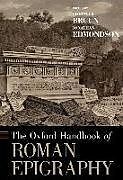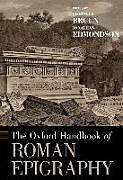The Oxford Handbook of Roman Epigraphy
Einband:
Fester Einband
EAN:
9780195336467
Untertitel:
Englisch
Genre:
Sprach- und Literaturwissenschaften
Autor:
Christer; Edmonson, Jonathan Bruun
Herausgeber:
Oxford Academic
Anzahl Seiten:
928
Erscheinungsdatum:
15.01.2015
ISBN:
978-0-19-533646-7
Zusatztext The authors of this volume! along with its editors! should be commended. Not only do they fulfill their major stated aim! that of explaining why inscriptions are important! but they have also produced chapters that are useful! accessible! up-to-dateand! in their own way! exciting. Informationen zum Autor Christer Bruun is Professor of Classics at the University of Toronto.Jonathan Edmondson is Professor of History at York University. Klappentext The study of inscriptions is critical for anyone seeking to understand the Roman world, whether they regard themselves as literary scholars, historians, archaeologists, anthropologists, or religious scholars. The Oxford Handbook of Roman Epigraphy is the fullest collection of scholarship on the study and history of Latin epigraphy produced to date. Zusammenfassung The study of inscriptions is critical for anyone seeking to understand the Roman world, whether they regard themselves as literary scholars, historians, archaeologists, anthropologists, or religious scholars. The Oxford Handbook of Roman Epigraphy is the fullest collection of scholarship on the study and history of Latin epigraphy produced to date. Inhaltsverzeichnis Preface; List of Contributors; Abbreviations; Map 1. Italy; Map 2. The Roman Empire under M. Aurelius and Commodus; PART I Roman Epigraphy: Introduction and History of the Discipline; 1. The Epigrapher at Work, Christer Bruun & Jonathan Edmondson; 2. Epigraphic Research since its Inception: Epigraphic Manuscripts, Marco Buonocore; 3. Forgeries and Fakes, Silvia Orlandi, Maria Letizia Caldelli, & Gian Luca Gregori; 4. The Major Corpora and Epigraphic Publications, Christer Bruun; 5. Epigraphy and Digital Resources, Thomas Elliott; PART II Inscriptions in the Roman World; 6. Latin Epigraphy: The Main Types of Inscriptions, Francisco Beltran Lloris; 7. Inscribing Roman Texts: officinae, layout, and carving techniques, Jonathan Edmondson; 8. The Epigraphic Habit in the Roman World, Francisco Beltran Lloris; PART III The Value of Inscriptions for Reconstructing the Roman World; Inscriptions and Roman Public Life; 9. The Roman Republic, Olli Salomies; 10. The Roman Emperor and the Imperial Family, Frederic Hurlet; 11. Senators and Equites: Prosopography, Christer Bruun; 12. Local Elites in Italy and the Western Provinces, Henrik Mouritsen; 13. Local Elites in the Greek East, Christof Schuler; 14. Government and Administration, Christer Bruun; 15. Laws, Lawmaking, and Legal Documents, Greg Rowe; 16. The Roman Army, Michael A. Speidel; 17. Roman History and Inscriptions: Political and Military Events, David Potter; 18. Late Antiquity, Benet Salway; Inscriptions and Religion in the Roman Empire; 19. Religion in Rome and Italy, Mika Kajava; 20. Religion in the Roman Provinces, James Rives; 21. The Rise of Christianity, Danilo Mazzoleni; Inscriptions and Roman Social and Economic Life; 22. The City of Rome, Christer Bruun; 23. Social Life in Town and Country, Garrett Fagan; 24. Urban Infrastructure and Euergetism outside the City of Rome, Marietta Horster; 25. Spectacle in Rome, Italy, and the Provinces, Michael Carter & Jonathan Edmondson; 26. Roman Family History, Jonathan Edmondson; 27. Women in the Roman World, Maria Letizia Caldelli; 28. Slaves and Freed Slaves, Christer Bruun; 29. Death and Burial, Laura Chioffi; 30. Communications and Mobility in the Roman Empire, Anne Kolb; 31. Economic Life in the Roman Empire, Jonathan Edmondson; Inscriptions and Roman Cultural Life; 32. Local Languages in Italy and the West, James Clackson; 33. Linguistic Variation, Language Change, and Latin Inscriptions, Peter Kruschwitz; 34. Inscriptions and Literacy, John Bodel; 35. Carmina Latina Epigraphica, Manfred Schmidt; APPENDICES; I Standard Epigraphic Conventions (Leiden Conventions); II Common Epigraphic Abbreviations; III Roman Onomastics; IV Roman Kinship Terms; V Roman Voting Tribes; VI Numbers; VII Digi...
The authors of this volume, along with its editors, should be commended. Not only do they fulfill their major stated aim, that of explaining why inscriptions are important, but they have also produced chapters that are useful, accessible, up-to-dateand, in their own way, exciting.
Autorentext
Christer Bruun is Professor of Classics at the University of Toronto. Jonathan Edmondson is Professor of History at York University.
Klappentext
The study of inscriptions is critical for anyone seeking to understand the Roman world, whether they regard themselves as literary scholars, historians, archaeologists, anthropologists, or religious scholars. The Oxford Handbook of Roman Epigraphy is the fullest collection of scholarship on the study and history of Latin epigraphy produced to date.
Zusammenfassung
Epigraphy, or the study of inscriptions, is critical for anyone seeking to understand the Roman world, whether they regard themselves as literary scholars, historians, archaeologists, anthropologists, religious scholars or work in a field that touches on the Roman world from c. 500 BCE to 500 CE and beyond. The Oxford Handbook of Roman Epigraphy is the fullest collection of scholarship on the study and history of Latin epigraphy produced to date. Rather that just a collection of inscriptions, however, this volume seeks to show why inscriptions matter and demonstrate to classicists and ancient historians how to work with the sources. To that end, the 35 chapters, written by senior and rising scholars in Roman history, classics, and epigraphy, cover everything from typograph to the importance of inscriptions for understanding many aspects of Roman culture, from Roman public life, to slavery, to the roles and lives of women, to the military, and to life in the provinces. Students and scholars alike will find the Handbook a crritical tool for expanding their knowledge of the Roman world.
Inhalt
Preface
List of Contributors
Abbreviations
Map 1. Italy
Map 2. The Roman Empire under M. Aurelius and Commodus
PART I Roman Epigraphy: Introduction and History of the Discipline
1. The Epigrapher at Work, Christer Bruun and Jonathan Edmondson
2. Epigraphic Research since its Inception: Epigraphic Manuscripts, Marco Buonocore
3. Forgeries and Fakes, Silvia Orlandi, Maria Letizia Caldelli, and Gian Luca Gregori
4. The Major Corpora and Epigraphic Publications, Christer Bruun
5. Epigraphy and Digital Resources, Thomas Elliott
PART II Inscriptions in the Roman World
6. Latin Epigraphy: The Main Types of Inscriptions, Francisco Beltrán Lloris
7. Inscribing Roman Texts: officinae, layout, and carving techniques, Jonathan Edmondson
8. The Epigraphic Habit in the Roman World, Francisco Beltrán Lloris
PART III The Value of Inscriptions for Reconstructing the Roman World
Inscriptions and Roman Public Life
9. The Roman Republic, Olli Salomies
10. The Roman Emperor and the Imperial Family, Frédéric Hurlet
11. Senators and Equites: Prosopography, Christer Bruun
12. Local Elites in Italy and the Western Provinces, Henrik Mouritsen
13. Local Elites in the Greek East, Christof Schuler
14. Government and Administration, Christer Bruun
15. Laws, Lawmaking, and Legal Documents, Greg Rowe
16. The Roman Army, Michael A. Speidel
17. Roman History and Inscriptions: Political and Military Events, David Potter
18. Late Antiquity, Benet Salway
Inscriptions and Religion in the Roman Empire
19. Religion in Rome and Italy, Mika Kajava
20. Religion in the Roman Provinces, James Rives
21. The Rise of Christianity, Danilo Mazzoleni
Inscript…

Leider konnten wir für diesen Artikel keine Preise ermitteln ...
billigbuch.ch sucht jetzt für Sie die besten Angebote ...
Die aktuellen Verkaufspreise von 6 Onlineshops werden in Realtime abgefragt.
Sie können das gewünschte Produkt anschliessend direkt beim Anbieter Ihrer Wahl bestellen.
Loading...
Die aktuellen Verkaufspreise von 6 Onlineshops werden in Realtime abgefragt.
Sie können das gewünschte Produkt anschliessend direkt beim Anbieter Ihrer Wahl bestellen.
| # | Onlineshop | Preis CHF | Versand CHF | Total CHF | ||
|---|---|---|---|---|---|---|
| 1 | Seller | 0.00 | 0.00 | 0.00 |
